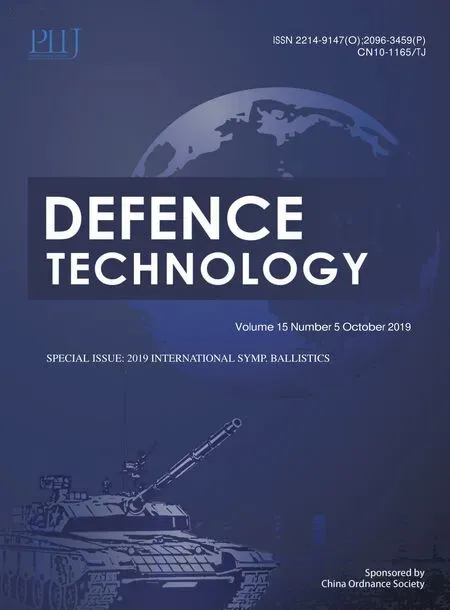Bore-center annular shaped charges with different liner materials penetrating into steel targets
Wen-long Xu , Cheng Wng ,*, Jin-ming Yun , To Deng
a State Key Lab of Explosion Science and Technology, Beijing Institute of Technology, Beijing,100081, China
b Temasek Laboratories, Nanyang Technological University, 50 Nanyang Drive, 637553, Singapore
Keywords:Annular shaped charge Liner material Formation Numerical simulation
ABSTRACT The bore-center annular shaped charge (BCASC) is a new type of shaped charge which can generate a larger-diameter hole in steel targets than classical shaped charges. In this paper, the influence of three liner materials, i.e. molybdenum, nickel and copper, on BCASC formation and penetrating into steel targets was investigated by experiment and numerical simulation. The simulation results were well consistent with the experimental results. This study showed that, at 0.50D standoff distance, the axial velocity of the molybdenum projectile was lower than that of the nickel and copper projectiles. The nickel and copper projectiles had almost the same head velocity. The absolute values of the radial velocity of the molybdenum projectile head was lower than that of the nickel and copper projectiles.However, at 0.75D standoff distance, the absolute values of the radial velocity of the molybdenum projectile head became much greater than that of the nickel and copper projectile heads. The projectile formed by BCASC with the molybdenum liner had the highest penetration depth of 61.5 mm, which was 10.0% and 21.3% higher than that generated by the copper and nickel projectiles.
1. Introduction
Classically shaped charges usually create small-diameter penetration holes, which cannot meet the requirements of largediameter penetration holes in some special applications, e.g.emergency rescue, a front shaped charge of tandem warhead, and others. Therefore, many researchers have investigated shaped charge technology of creating large-diameter holes in hard targets[1e3].Leidel[4]designed an annular-jet shaped charge by adding a steel cylinder in charge part.His study showed that the parameters of liner wall thickness variation had an important effect on the formation and penetration of annular-jet shaped charge. K€onig et al. [5] designed a shaped charge which could form an annular EFP. Their study showed that the diameter of the annular EFP formed by the structure was the same to the charge diameter;meanwhile, the length of the EFP was 1/3 times of the charge diameter.By adding a focusing structure on the traditional annular shaped charge,Xu et al.[6]proposed a new type of annular shaped charge.Based on an orthogonal optimization method,they studied the influence of the liner thickness, cone angle of the focusing structure,the diameter of the nozzle and the thickness of the shell on axial and radial velocity of annular jet.The experimental results showed that the new type of annular shaped charge could form a large-diameter annular hole in steel targets.Grace et al.[7]studied the effect of initiation mode on jet formation of annular shaped charge. Their research indicated that a modest initiation radius could form a tubular jet and peripheral initiation, which caused inward jet flow and thus ultimately resulted in a reconstituted jet.
The liner is the key component of a shaped charge, and its material selection has an important influence on its penetration capability [8e10]. Through theoretical analysis and numerical simulation,Meister et al.[11]designed two kinds of annular shaped charge,i.e.,the center-reversed charge and the outer-wall-reversed charge. The experimental results of annular shaped charge with four different liner materials, iron, aluminum, lead and tantalum,showed that the four materials could form an annular jet with certain penetration ability. Wang et al. [12] investigated the effect of liner material(copper,steel,and aluminum)of the shaped charge on jet formation and its penetration capability by experimental and numerical methods.Their study showed that the velocity of copper jet with the strongest penetration capability was higher than that of steel jet but lower than that of aluminum jet.The aluminum jet had the largest velocity with the poorest penetration capability.Zhang et al. [13] studied the influence of liner material on shaped charge penetration created by underwater explosion. As for aluminum, copper and steel liner materials, the jet velocity in the case with the aluminum liner was higher than that for the other two cases. However, the aluminum jet demonstrated the poorest penetration capability. It implies that higher velocity does not always have more serious damage effect.
In this work,we studied the BCASC made of three different liner materials on formation and penetrating into steel targets by experimental and numerical methods.The experimental setup and penetration results of BCASC were presented in section 2, meanwhile the simulation models, material models and parameters were provided in section 3.The validity of the numerical simulation is verified by comparing the numerical simulation results with the test data. Furthermore, the effects of the liner materials on the BCASC formation progress are discussed. Section 4 summarizes some conclusions.
2. BCASC experiments
The bore-center annular shaped charge (BCASC) used in experiments is shown in Fig.1.The BCASC is mainly composed of a liner,steel shell and composition B explosive(TNT:RDX¼40%:60%).The D100 mm×L180 mm cylindrical explosive is fully filled in the shell. The thickness of the shell is 2.0 mm.Design and structure of the liners of BCASC is shown in Fig. 2. Three materials of molybdenum,nickel and copper were used for the liners in experiments to study the effect of liner materials on formation and penetration of BCASC. The dimensions of the liners are given in Fig. 2 (b).
The test setup of BCASC penetrating into targets is illustrated in Fig.3.The material of the targets is 4340 steel.The booster charge with diameter of 25.0 mm was mounted in the end of the BCASC sample. After the booster charge was initiated by a detonator, it would detonate the main charge inside the BCASC sample. The standoff distance between the BCASC sample and the target is 75.0 mm. The targets were made of two stacked cylinders. The diameter of the cylinder target is 250.0 mm and the height is 80.0 mm.
Penetration results of the BCASC with three materials at the standoff distance of 0.75D are shown in Fig. 4. All the projectiles were able to generate an annular bullet hole with a rough central conical core in the targets. As listed in Table 1, penetration diameters of annular hole formed by the molybdenum and nickel projectiles are slightly larger than that formed by the copper projectile. The projectile formed by BCASC with the molybdenum liner has the highest penetration depth of 61.5 mm,which is 10.0%and 21.3% higher than that of the copper and nickel projectiles,respectively.

Fig.1. The structure of a bore-center annular shaped charge.

Fig. 2. Design of the liners.
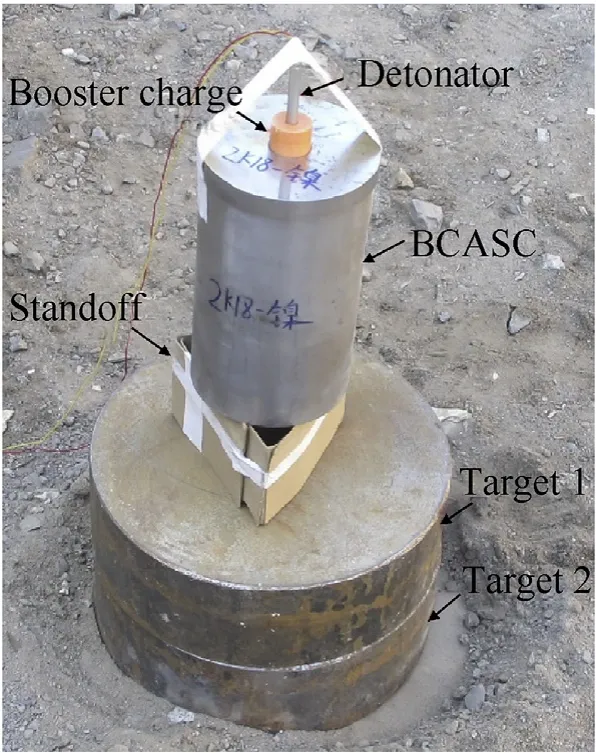
Fig. 3. Test setup of bore-center annular shaped charge penetrating into steel targets.
3. Numerical simulation
3.1. Numerical simulation methods
The remapping technology in hydrocode Autodyn was applied to study formation and penetration of BCASC with different liner materials of molybdenum,nickel and copper.Firstly,the formation process of BCASC projectiles was simulated by using Euler solver and 2-dimensional axisymmetric formulation, as shown in Fig. 5.
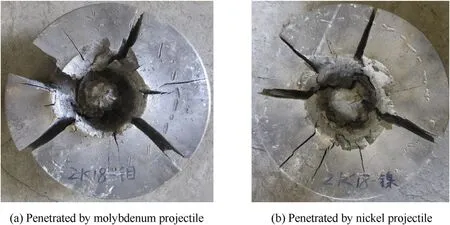
Fig. 4. Penetration results of the BCASC with three materials at 0.75D standoff distance.

Table 1 The measured parameters of the penetrated target.

Fig. 5. The simulation model for the formation of BCASC with molybdenum liner.
The coordinate origin is located at the axis of the central hole of the liner with a simulation region of 400 mm×160 mm and flow-out non-reflection boundaries. Secondly, the simulated results were remapped into the 2D axisymmetric Lagrange mesh to simulate the penetration progress, as shown in Fig. 6. As presented in the previous study[1],to balance reasonable accuracy and computational costs,the size of square mesh for both the Euler and Lagrange was set to be 0.4 mm×0.4 mm.
The ideal gas model with the below equation of state (EOS) is applied,

The composition B explosive is described by JWL EOS

where PBis the pressure;V ¼1=rBis the specific volume;rBis the density of composition B;E0is the specific internal energy per unit mass; A1, B1, R1, R2and u are material constants. The input values are listed in Table 2.
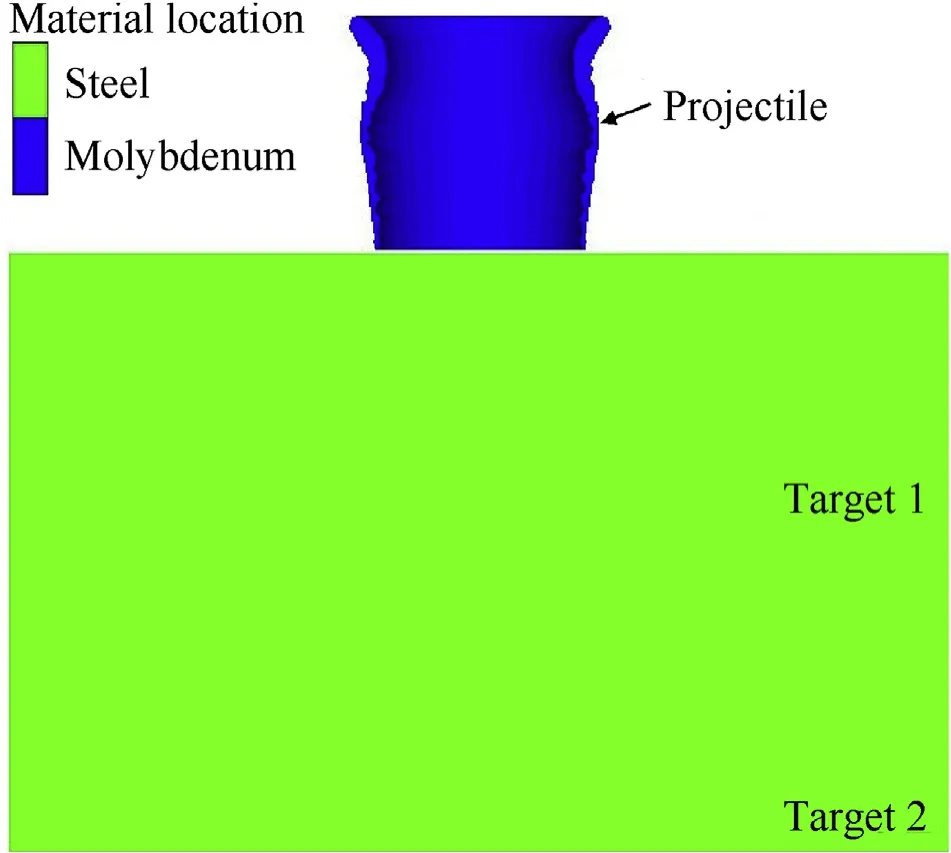
Fig. 6. The simulation model for the penetration of BCASC with molybdenum liner.
The EOS of the molybdenum,nickel and copper liner is a shock model.And,the strength model of liner is neglected because a liner behaves like a fluid under the extremely large pressure and temperature during collapse [14]. The relationship between material shock velocity (US) and particle velocity (up), is specified as

where C0is the bulk acoustic sound speed, S is a constant.
Based on the shock Hugoniot,a Mie-Gruneisen form of the EOS is established


The EOS of the steel material(shells and targets)is also a shock model and the strength is described by Johnson-Cook model which defines the yield stress Y as

where εPis effective plastic strain,withis normalized effective plastic strain rate andis the homologous temperature,Tmeltis the melting temperature,Troomis the room temperature,A,B,C,n and m are the material constants.The detailed parameters of the above models are obtained from the Autodyn material library.The input values of the liner,shell and target materials are listed in Table 3.
3.2. Verification of simulation model
At 0.75D standoff distance, the progress of BCASCs with different liner materials penetrating into steel targets are shown in Fig. 7. As shown in simulation results, the penetrated hole walls display a blade shape, which is caused by the radial impact of the projectile. The predicted penetrated diameter and depth of the annular hole are all smaller than the experimental results. The maximum deviation in the diameter and depth of the annular holes between the numerical simulation results and the experimental ones are -9.5% and -8.1%, respectively (see Table 4). The simulation results are consistent well with the test data, indicating that the established simulation model is reliable.
3.3. Discussion
The radial velocities (VY) of the projectile are given by the velocity of the elements along a straight path(measuring line)whichpasses the center of the projectiles formed by the liner. The distribution of the radial velocities of the projectiles along the path at 0.50D standoff distance is shown in Fig.8.Along with the direction of the projectile length,the radial velocity of the projectiles formed by the three different liner materials decreases first,then increases and decreases again. Between the tail and the middle part, the difference of the radial velocity of the projectile formed by the three linear materials is negligible.The radial velocity of all the projectile heads is negative, which means, at 0.50D standoff distance, the head of the projectile deflects towards the axis of the charge.Compared to the nickel and copper projectiles,the absolute values of the radial velocity of the head of the molybdenum projectile is obviously lower.

Table 3 The input parameters for the liner, shell and target materials.
The axial velocities of the projectile mode of the three different liner materials are plotted in Fig. 9. It can be seen that the axial velocities of the projectile gradually increase along the length.Both the nickel and copper projectiles display the same velocity profile,but the axial velocity of the molybdenum projectile is lower than that of the nickel and copper projectiles. However, the numerical simulation and experimental results show that the penetration depth of the molybdenum projectile is higher than that of copper and nickel projectiles.Considering that the density of molybdenum material is much larger than that of copper and nickel, this means that the penetration ability of the projectiles is not only related to the penetration velocity, but also affected by the density of the projectile materials.
The projectiles formed by three liner materials at the moment of impact targets (0.75D) are illustrated in Fig.10. The velocity (axial velocity VX’, radial velocity VY’) and diameter (DP) of the projectile head and length of the projectile (LP) formed by the three liner materials are listed in Table 5.It is consistent with the conclusions obtained at 0.50D, for 0.75D standoff distance the VX’ value of molybdenum projectile is less than that of nickel and copper projectiles. However, at 0.75D standoff distance, the radial velocity of the molybdenum projectile head is positive,indicating the head of the projectile turns away from the axis of the charge. Meanwhile,the radial velocity of the head of the molybdenum projectile is much higher than that of the nickel and copper projectile.Both the nickel and copper projectiles display the same configurations with the same DPand LP,but the values of DPand LPfor the molybdenum projectile is slightly larger than that of the nickel and copper projectiles.Although the diameter(DP)of the projectile head is smaller than that of the charge,the diameter of the penetration hole on the targets is larger than that of the charge because of the radial velocity of the projectiles.
4. Conclusions
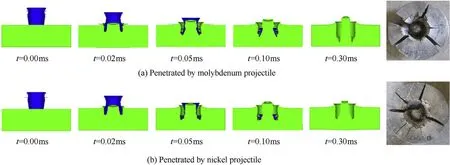
Fig. 7. The progress of BCASCs with different liner materials penetrating into steel targets.

Table 4 The details of numerical and experimental results.

Fig. 8. Distribution of radial velocities of the projectiles along the length at 0.50D standoff.
The effect of the liner materials, i.e. molybdenum, nickel and copper, on the BCASC formation and penetrating into steel targets are investigated by simulation and experiment.The conclusions are drawn as follows:
1) The projectile formed by BCASC with molybdenum liner has the highest penetration depth of 61.5 mm,which is 10.0%and 21.3%higher than that of the copper and nickel projectiles, respectively(Table 1 and Fig. 4).
2) Along with the direction of the projectile length, the radial velocity of the projectiles formed by the materials of molybdenum,nickel and copper decreases first, then increases and decreases again (Fig. 8).
3) At 0.50D standoff distance, the velocity of nickel and copper projectiles head is similar. The absolute values of the radial velocity of the molybdenum projectile head is less than that of the nickel and copper projectile heads (Fig. 8). The axial velocity of the molybdenum projectile is less than that of the nickel and copper projectiles (Fig. 9).
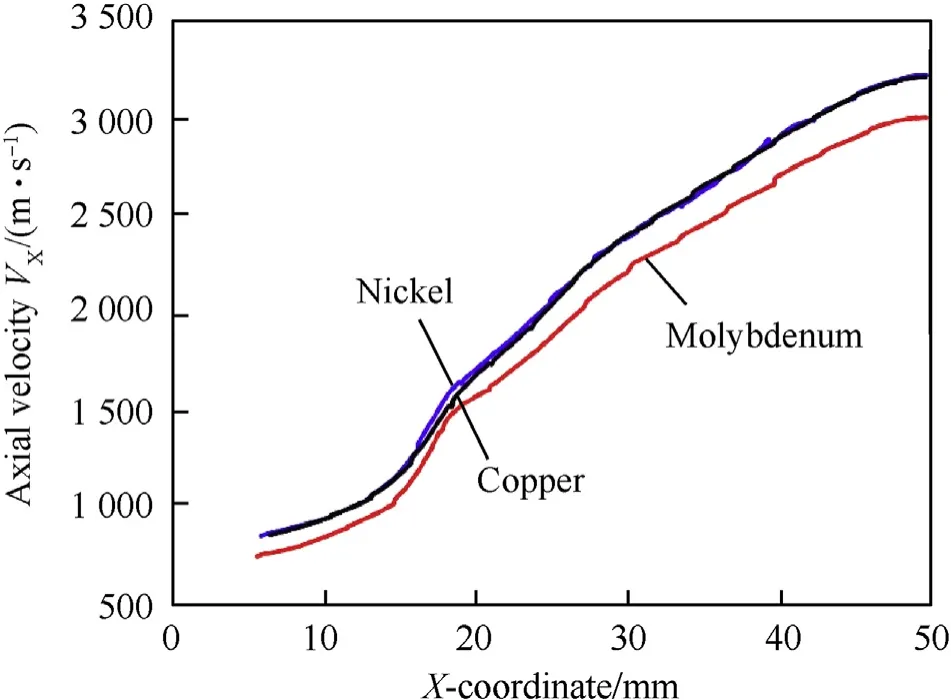
Fig. 9. Distribution of axial velocities of the projectiles along the length at 0.50D standoff.
4) At 0.75D standoff distance, the diameter (DP) of the projectile head and length (LP) of the projectile formed by BCASC with nickel and copper liners are exactly the same. The values of DPand LPof molybdenum projectile is slightly larger than that of the nickel and copper projectiles. The absolute values of the radial velocity of the molybdenum projectile head is much larger than that of the nickel and copper projectile heads(Fig.10 and Table 5).
The experiments show radial cracking in the targets (Fig. 7),which two-dimensional symmetrical simulation presented in this paper is unable to predict. Three-dimensional simulation work is on-going to investigate how radial cracking affects BCASC penetration into steel targets.

Fig.10. The projectiles formed by three liner materials at the moment of impact targets (0.75D).

Table 5 The key parameter values of projectiles at the standoff distance of 0.75D.
Acknowledgments
This research is supported by the National Natural Science Foundation of China (No. 11732003), Beijing Natural Science Foundation (No. 8182050), Science Challenge Project (No.TZ2016001) and National Key R&D Program of China(No.2017YFC0804700).
- Defence Technology的其它文章
- 31st International Symposium on Ballistics, Hyderabad, India, 4e8 November 2019
- Analysis of global momentum transfer due to buried mine detonation
- Modeling of the whole process of shock wave overpressure of freefield air explosion
- Experimental studies of explosion energy output with different igniter mass
- Investigation on the influence of the initial RDX crystal size on the performance of shaped charge warheads
- Deformation, fragmentation and acceleration of a controlled fragmentation charge casing

